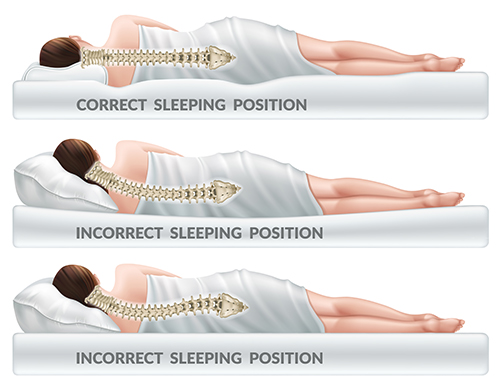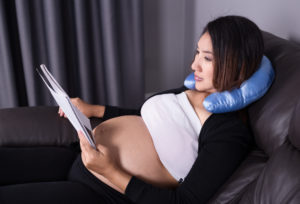Sleeping Positions for Back and Neck Pain

Getting a good night’s sleep can be tough with back or neck pain. It’s a vicious cycle. You need sleep to heal, but your back hurts so you can’t sleep, so you can’t heal, so your back still hurts and you can’t sleep.
The non-restorative sleep that is typical when you’re in pain prevents the relaxation of your muscles and impedes the healing that normally occurs during sleep. During restful sleep, the heart and blood pressure slow, the brain is able to release the hormones that stimulate tissue growth and repair blood vessels, the body makes more white blood cells and the immune system is boosted.
If sleeping well is that important to healing back pain and neck pain, how do you do it? Here’s how to sleep when your back hurts.
Sleeping Positions
While it is best to choose recommended sleeping positions, that can be difficult for those who find an unaccustomed sleeping position just as stressful as the pain they are experiencing. So, if a sleep position is not comfortable, it may not be right for you.

Keep in mind the bottom line: You should sleep in whatever position helps you to rest, but also allow for modifications. The key to good sleep posture is alignment—keeping your ears, shoulders and hips in a straight line (more or less). There will naturally be gaps between spaces on your body and the mattress. These spaces can strain your back or neck muscles, so you should use pillows to fill in these gaps and reduce the stress.
Secondly, people often move around when they sleep. So, it doesn’t pay to worry and add more stress about keeping one sleep position. In the event you do move, keep more pillows around you that can use to help support vulnerable areas in various sleep positions.
Best Sleeping Positions for Back Pain
The best sleeping position for lower back pain is widely considered to be on your back. This position distributes the weight along the entire spine. Placing a pillow under your knees will help to maintain the natural curve of the spine.
For those who sleep on their side, placing a firm pillow between the knees helps to maintain the natural alignment of the hips, pelvis and spine. However, if you are a side sleeper, try to alternate sides. This will help to avoid muscle imbalance and perhaps even scoliosis. In addition, side sleeping in a curled-up fetal position may help those with herniated disc pain.
Lying on your stomach is considered the worst sleeping position for back pain. However, if it is difficult to change sleeping positions, place a thin pillow underneath your hips and stomach to improve the alignment of the spine.
Best Sleeping Positions for Neck Pain

The best sleeping positions for the neck are on your back or your side. The back in particular is recommended; just make sure to use a pillow that supports the curvature of your neck and a flatter pillow to cushion your head.
If you sleep on your side, use a taller pillow under your neck so your neck aligns with your head. This will relieve any strain on your neck and keep your spine straight.
The trouble with sleeping on your stomach is that you have to twist your neck to keep your head on its side, which puts pressure on the nerves. You can try to retrain yourself to adopt another position, using pillows to coax yourself and to support you in a side or back-lying position. If you must sleep on your stomach, use a thin pillow or no pillow, trying to keep awkward angles at a minimum.
For all sleep positions with neck pain, you should use a pillow under your neck that provides support, such as a rolled towel or cervical pillow.
There is also such a thing as neck pain from sleeping wrong. Sometimes you wake up with neck pain. Sleeping at an awkward angle, sudden head or neck movements during sleep or neck strain from injury may cause neck pain. In addition to utilizing treatments to relieve this neck pain, make sure that future sleep includes a good pillow for neck support.
Sleeping Upright
Many people find relief for both back and neck pain by sleeping in an upright position or in a recliner. This is common among pregnant women, for example, for their back pain. If you choose this position, the best accompaniment is a horseshoe shaped pillow to support the neck, such as the kind often used on airplane flights. Lower back pillows are also a good idea.

Pain-free Sleep Extras
In addition to sleep positions, take the time to determine the best equipment and environment for your optimal sleep. Creative use of pillows can really help dial in a comfortable sleeping position. If your pillows are old and inappropriate, replace them. Also, you may need to test a variety of models to know what is best for you.
The same is true for a mattress. Is it time to get a new one? Like pillows, there is no universal best choice for a mattress. Despite recommendations, what’s good for one person is not necessarily right for another. Again, try to test a mattress by sleeping on it: a friend’s guest bed, a hotel, or however possible.
Finally, create a restful environment. Room temperature, where you place your bed, how you darken the room, how you organize your sleep space and how you treat screen time—all can help contribute to a restful, pain-free sleep.
If you are experiencing back or neck pain, request an appointment at Edison Spine Center. We can tell you what’s wrong and give you the tools you need to fix it.
